- Table of Content
- 1.Radio Sun!
- 2.Open Topical I...
- 3.PhD positions ...
- 4.Review of sola...
- 5.Review of geom...
- 6.Noticeable Sol...
- 7.PROBA2 Observa...
- 8.International ...
- 9.Geomagnetic Ob...
- 10.Review of iono...
- 11.Agenda
2. Open Topical Issues in JSWSC
3. PhD positions in space and machine learning
4. Review of solar activity
5. Review of geomagnetic activity
6. Noticeable Solar Events
7. PROBA2 Observations (1 May 2023 - 7 May 2023)
8. International Sunspot Number by SILSO
9. Geomagnetic Observations in Belgium
10. Review of ionospheric activity
11. Agenda
Radio Sun!
From 1 May onwards, a new grouping of active sunspot groups rotated over the northeast solar limb. The trio consisted of active regions NOAA 3293, 3296 and 3297. NOAA 3297 was the largest group, but had a relatively simple magnetic configuration and thus produced only some C-class flaring. NOAA 3293 contained initially a delta structure in its middle portion (see last week's newsitem at https://www.stce.be/news/643/welcome.html ), which resulted in 4 M-class flares on 3 May, including the strongest flare of that week (M7.2). The SDO/HMI images underneath (http://sdo.gsfc.nasa.gov/data/aiahmi/ ) show the sunspot groups in white light (left) and the corresponding magnetogram (right) late on 3 May, i.e. when the delta structure in NOAA 3293 was disentangling. In the magnetogram, the white colour denotes magnetic field lines coming out of the solar surface ("positive" polarity), the black colours mean magnetic field lines returning to the solar surface ("negative" polarity).
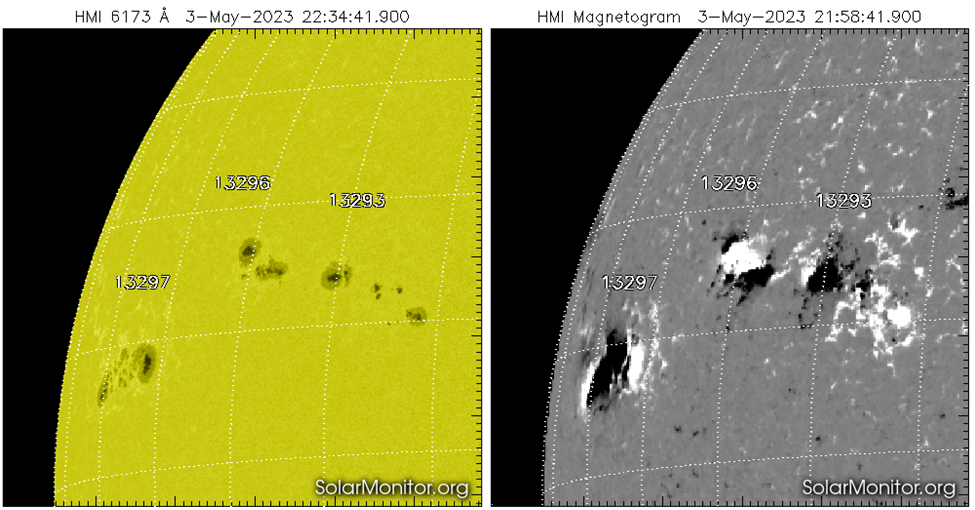
Sunspot group NOAA 3296 then took over from NOAA 3293 in terms of flare production. NOAA 3296 had actually a reversed magnetic polarity, meaning that it had a magnetic configuration opposite to what can be expected for bipolar sunspot regions in the northern solar hemisphere this solar cycle. This can also be seen in the magnetogram above, where the leading sunspot of NOAA 3296 has a negative polarity (black colour) and the main trailing spot a positive polarity (white colour), opposite to the configuration in sunspot regions NOAA 3293 and 3297. Sunspot groups with such an inverted (also known as "anti-Hale") configuration are not too numerous, with only between about 3 to 8% of all sunspot groups during a solar cycle (see e.g. McClintock et al. 2014 - https://iopscience.iop.org/article/10.1088/0004-637X/797/2/130 ). It has been shown statistically that these groups have a higher likelihood on producing solar flares (Toriumi et al. 2019 - https://link.springer.com/article/10.1007/s41116-019-0019-7 ), and NOAA 3296 supported this by producing 4 M-class flares over the next 4 days. The graph underneath (GOES - https://www.swpc.noaa.gov/products/goes-x-ray-flux ) shows the first two (and strongest) flares from this region: an M3.9 flare on 4 May, and an M2.1 flare on 5 May. Both were long-duration events. The SDO/AIA 094 imagery (https://sdo.gsfc.nasa.gov/data/aiahmi/ ) shows the two flares in extreme ultraviolet near the time of the flare peak. A clip can be found in the online version of this newsitem at https://www.stce.be/news/644/welcome.html
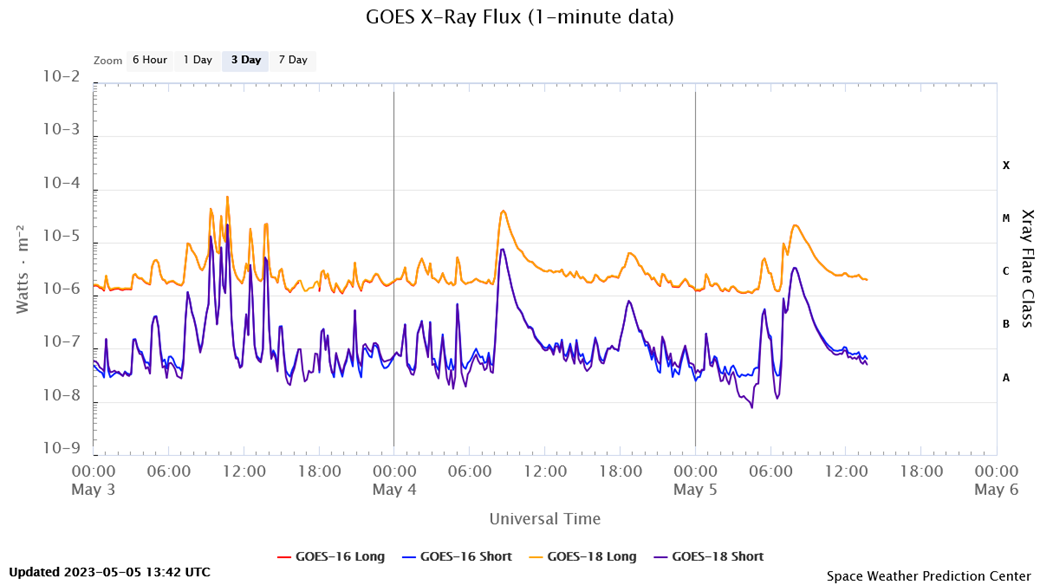
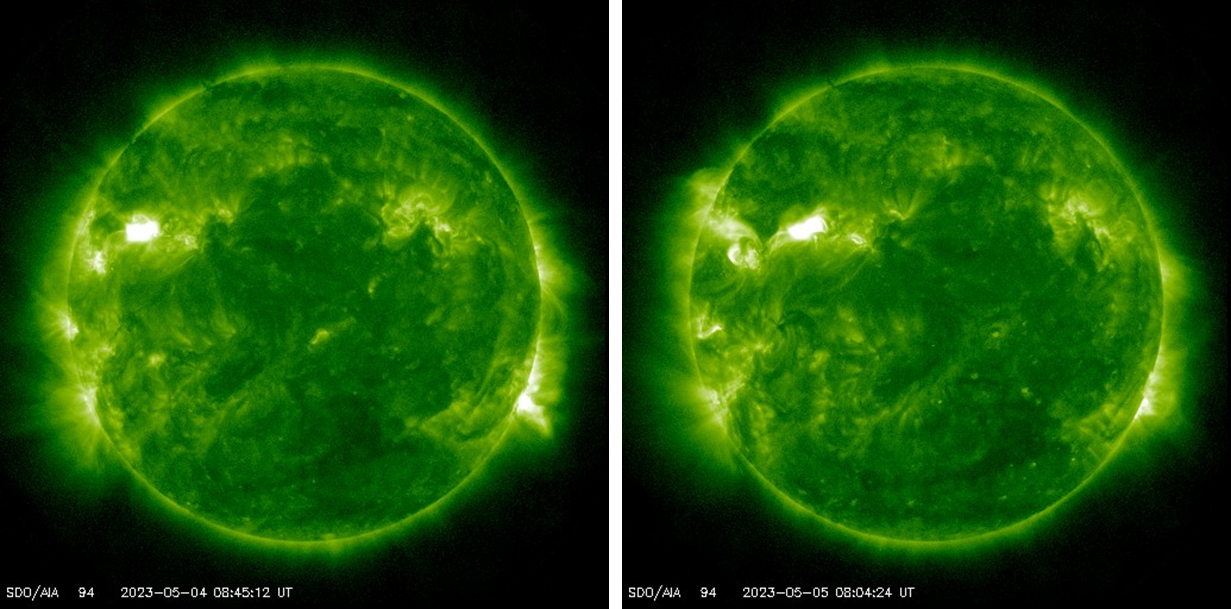
These two flares were accompanied by important emissions on radio frequencies. In particular the 4 May M-class flare produced one of the strongest radio bursts on GNSS frequencies (Global Navigation Satellite System, such as GPS and GALILEO) so far this solar cycle. The Radio Solar Telescope Network (RSTN ; NOAA/SWPC event reports - https://www.swpc.noaa.gov/products/solar-and-geophysical-event-reports ) reported a peak value of 26.000 sfu (solar flux units - https://www.stce.be/educational/acronym#S ) at 1415 MHz around 09:30 UTC. This is a relatively high value compared to the typical quiet Sun value during solar cycle maximum (around 100 sfu) and other radio bursts at these frequencies (usually a few 100 to a few 1000s sfu). The radio spectrogram underneath was recorded by the radio telescopes at Humain, Belgium (https://www.sidc.be/humain/home ). It shows for the period from 07:00 till 13:00 UTC (horizontal axis) the intensity (coloured) over the frequency range from 45 to 1495 MHz (vertical axis). The top of the graph shows the evolution in soft x-rays as recorded by GOES.
From around 08:30 till 10:30 UTC, there's a clear enhancement of radio emission between 200 MHz and (beyond) 1495 MHz. This is called a Type IV radio burst, i.e. quasi–continuum features over a wide range of frequencies associated with the decay phase of solar flares. They are attributed to electrons trapped in closed field lines in the post–flare coronal loops produced by flares, implying an ongoing acceleration somewhere in these loops (White 2007 - https://www.astro.umd.edu/~white/papers/07_ajp_gbsrbs.pdf ). Type IV bursts have long been of interest in space weather studies because they are often associated with solar energetic particle events, which were however not observed during the 4 and 5 May M-class flares. More examples can be found at the STCE's SWx classification page (https://www.stce.be/educational/classification#radio ).
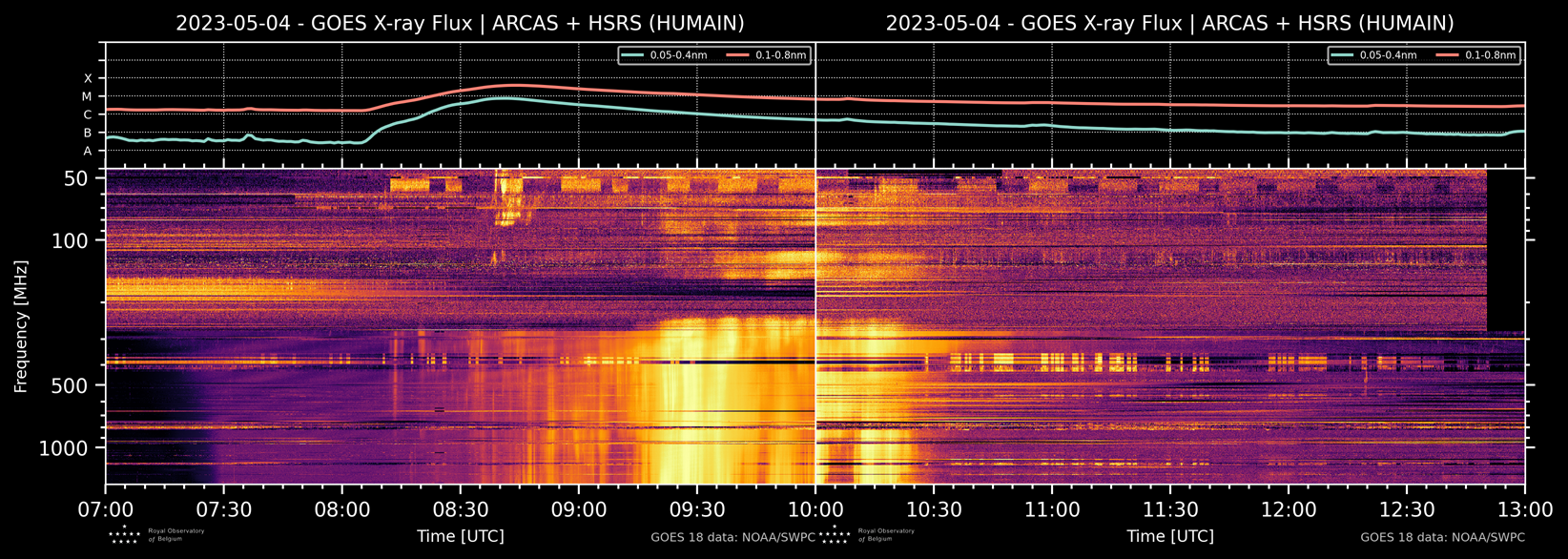
In the past, strong Type IV radio emissions ("radio noise") have been the source of severe GNSS outages. Notorious are the 6 December 2006 (Cerruti et al. 2008 - https://doi.org/10.1029/2007SW000375 ) and 24 September 2011 (Sreeja et al. 2013 - https://doi.org/10.1002/swe.20057 ) events where maximum power of respectively 1.000.000 (1 million!) sfu and 110.000 sfu at GNSS frequencies were recorded. The map underneath was based on Figure 3 of the Sreeja et al. (2013) paper and shows the impact of the 24 September 2011 radio burst on the GNSS technologies at 13:04 UTC. The dots indicate the approximate location of the GNSS receivers analyzed in the Sreeja study. A blue coloured dot indicates that the normal number of satellites were being tracked (4 or more). Prior to the burst, all dots were blue. During the burst, which adds a lot of radio noise at the GNSS frequencies, several sunlit receivers were not able to track the four satellites required for a full positioning solution (marked in red). Similar effects were observed during the 6 December 2006 radio burst, but this time the affected area was much wider, with impacted receivers located over the United States, Latin-America, the middle and eastern portion of the Pacific, and even Antarctica (see Figure 6 of the Cerruti et al. (2008) paper). Any effects from the 4 May radio burst, as well as from the 2 strongest bursts so far this solar cycle on 28 August 2022 (saturation effects?) and on 13 June 2022 (98.000 sfu by San Vito (Italy) at 1415 MHz; 64.000 sfu by Nobeyama (Japan - http://solar.nro.nao.ac.jp/norp/) at 1 GHz) are thought to be much smaller and of much shorter duration than the 2006 event, and are currently being scrutinized.
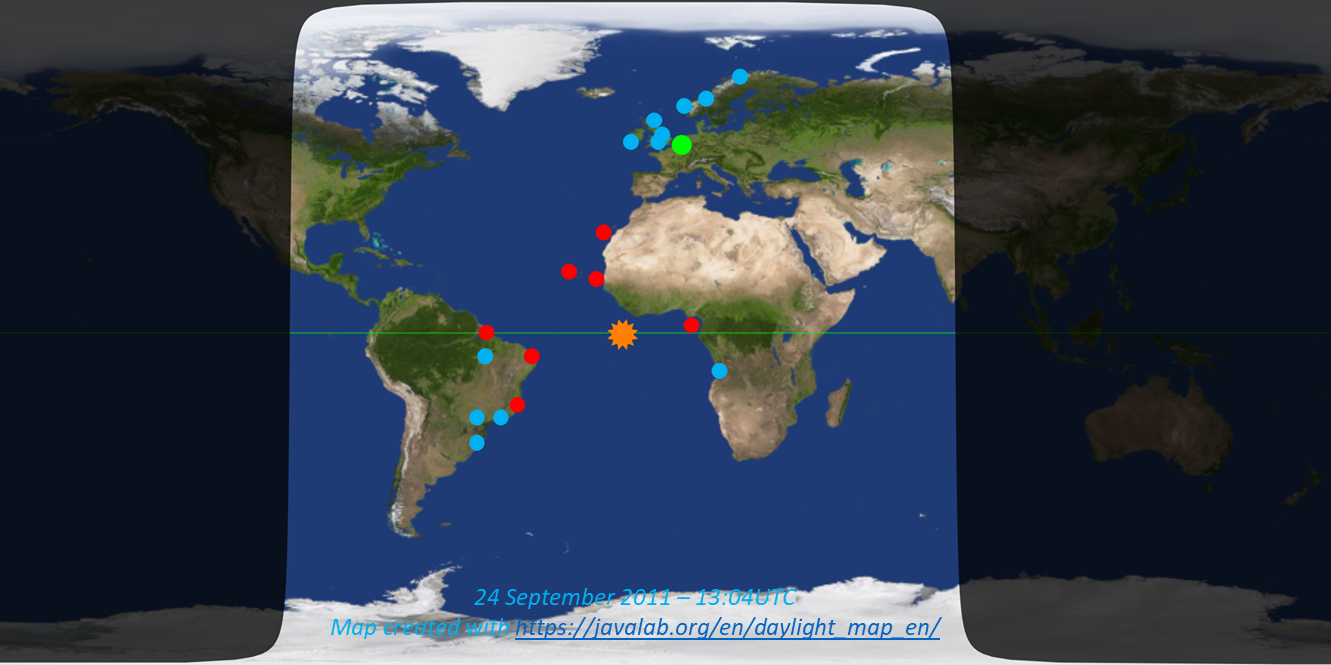
Background map created with Javalab (https://javalab.org/en/daylight_map_en/ ).
Open Topical Issues in JSWSC
The Journal of Space Weather and Space Climate (JSWSC - https://www.swsc-journal.org/ ) currently has 3 Topical Issues (TIs) open for submission. Details and practicalities can be found on the related website at https://www.swsc-journal.org/topical-issues-open-for-submission , with a summary for each TI underneath.
Topical Issue - CMEs, ICMEs, SEPs: Observational, Modelling, and Forecasting Advances
- Deadline: 31 July 2023
- Topic: This TI aims at highlighting recent advances in the study of coronal mass ejections (CMEs), Interplanetary CMEs (ICMEs) and Solar Energetic Particles (SEPs), and in the forecasting of their space weather impact at Earth and other locations in the heliosphere. Contributed papers may present recent developments in the observational, theoretical, and modelling investigation of CMEs,ICMEs and SEPs, including (but not limited to): ICME propagation in the heliosphere, the interaction of ICMEs with terrestrial and planetary environments, the link between CMEs and ICMEs, the generation and transport of SEPs by CME- or ICME-driven shocks, and the forecasting of ICME and SEP occurrence, characteristics, and space weather impacts.
- Topical Editor-in-Chief (T-EiC): Camilla Scolini (University of New Hampshire, USA)
- Topical Editors (TE): Luciano Rodriguez (Royal Observatory of Belgium, Belgium), Sergio Dasso (Universidad de Buenos Aires, Argentina), and Nicolas Wijsen (NASA GSFC and University of Maryland College Park, USA)
Topical Issue - Space Climate: Long-term effects of solar variability on the Earth's environment
- Deadline: 31 August 2023
- Topic: This TI invites all contributions aiming at understanding long-term variability of solar activity and its effects on the heliosphere, the Earth's space environment, atmosphere and climate. This, in particular, includes the following research questions: What are the causes, manifestations and effects of long-term variations in solar activity? How do variations in solar activity, whether continuous or transient, affect the Earth's space environment, atmosphere and climate system on timescales up to millennia? What are the intricacies in the different datasets used to make inferences about long-term solar variations, like the sunspot number time series and geomagnetic observations? We welcome all manuscripts considering these aspects of Space Climate.
- Topical Editor-in-Chief (T-EiC): Agnieszka Gil (Siedlce University of Natural Sciences and Humanities and Space Research Centre PAS, Poland)
- Topical Editors (TE): Timo Asikainen (University of Oulu, Finland) ; Nat Gopalswamy (NASA Goddard Space Flight Center, USA), and Miriam Sinnhuber (Karlsruhe Institute of Technology, Germany)
Topical Issue - Solar Sources of Space Weather
- Deadline 30 September 2023
- Topic: We invite contributions on studies that focus on the build-up, origin, triggering, and early dynamics of solar eruptive events, as well as on space weather effects driven by non-eruptive events, such as HSSs that provide better characterization, diagnostics and deeper physical understanding of the solar sources of space weather at Earth and anywhere in the heliosphere. The scope of this topical issue covers both observational and modelling approaches, as well as new techniques and studies on the conditions for moderate to extreme events, which are key to improve space weather predictions.
- Topical Editor-in-Chief (T-EiC): Judith de Patoul (Solar-Terrestrial Centre of Excellence, Royal Observatory of Belgium, Brussels, Belgium)
- Topical Editors (TE): Hebe Cremades (Grupo de Estudios en Heliofísica de Mendoza, CONICET, Universidad de Mendoza, Mendoza, Argentina), Yana Maneva (Solar-Terrestrial Centre of Excellence, Royal Observatory of Belgium, Brussels, Belgium), Erika Palmerio (Predictive Science Inc., San Diego, CA, USA), Li Feng (Purple Mountain Observatory, Chinese Academy of Sciences, Nanjing, China), Tshimangadzo Merline Matamba (South African National Space Agency, Hermanus, South Africa).

PhD positions in space and machine learning
Three PhD Positions in space and machine learning at the Center for mathematical Plasma Astrophysics -KULeuven (Belgium)
Within the new ERC Advanced Grant TerraVirtualE (PI Lapenta), we advertise 3 PhD positions to join the team of Prof. Giovanni Lapenta.
Selected candidates will work on the study of the Earth Space Environment (called Magnetosphere) using observations from space missions, theory, simulation and artificial intelligence.
We foresee three possible focuses, one for each selected PhD candidate and/or in collaboration:
*The study of fundamental processes in the Earth space environment using theory, simulation and observational data (e.g. from the Magnetospheric Multiscale Mission)
* The development of supercomputer simulations of the Earth space environment using the newest supercomputers available in Europe and worldwide
* The use of artificial intelligence (AI) techniques to analyse processes and data sources relative to the Earth space environment
Contact: giovanni.lapenta@kuleuven.be
For more information please follow the link in the picture below.
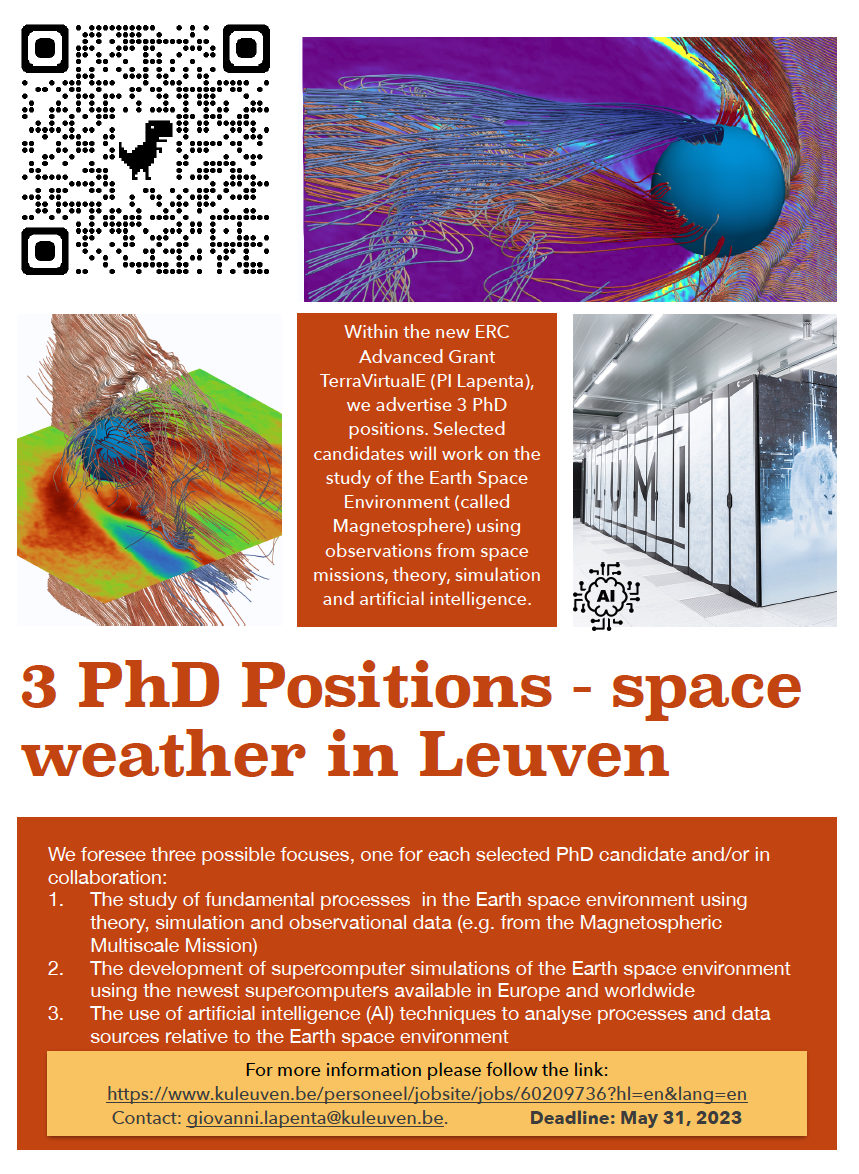
Review of solar activity
Flaring activity
Solar flaring activity was at a low levels for most of the past week with the exception of 27 Apr and 30 Apr. NOAA Active Region (AR) 3288 (magnetic configuration Beta, Catania group 67) produced an M1 flare at 27 Apr 11:14 UT, while NOAA AR 3293 (magnetic configuration Beta-Delta) produced an M2 flare at 30 Apr 20:30 UT. Numerous C-class events were detected during the past week, mostly from NOAA AR 3285 (magnetic configuration Beta, Catania group 65) and NOAA AR 3288 that were closely located and in the process of merging during the past week.
Solar Wind Disturbances: Coronal Mass Ejections
There were multiple Coronal Mass Ejections (CME) observed over the week, but only two were judged to have a small chance of affecting the Earth environment. The first one was a partial halo CME that could be seen in LASCO/C2 images starting from 27 Apr 01:25 UT and was estimated to arrive at 29 Apr. The second one was also a partial halo CME that could be seen in LASCO/C2 images starting from 29 Apr 01:36 UT and was estimated to arrive at 1 or 2 May. None of the two CME arrived on Earth.
Solar Wind Disturbances: Coronal Holes
A small equatorial coronal hole (CH) of negative polarity started crossing the solar central meridian at 24 Apr. A northern CH with negative polarity also crossed the central meridian during 27 Apr.
Energetic particles near Earth
The greater than 10 MeV proton flux was at nominal levels over the past week. The greater than 2 MeV electron flux was below the 1000 pfu alert threshold from the start of the previous week until the 26 Apr noon UT and above the limit for the majority of the time for the rest of the week. Similarly, the 24h electron fluence was at nominal levels until 26 Apr 15:20 UT and increased to moderate levels for the rest of the past week.
Review of geomagnetic activity
Solar wind conditions at L1
Solar Wind (SW) was dominated by the arrival of a Corona Mass Ejection (CME) at 23 Apr and a High Speed Stream (HSS) at 26 Apr that lasted until the end of the week. The CME arrival caused an increase of the SW speed to 650 km/s and of the total interplanetary magnetic field (Btot) to 35 nT. The North-South component of the magnetic field (Bz) dropped to -35 nT and the interplanetary magnetic field was predominantly directed towards the Sun while influenced by the CME. On 25 Apr, the effects of the CME waned significantly, until the arrival of the HSS. The SW speed then increased to 700 km/s, although Btot remained below 10 nT and Bz fluctuated between -9 and 9 nT. The phi angle was predominantly directed towards the Sun while affected by the HSS.
Geomagnetic conditions
Geomagnetic conditions reached the severe storm and strong storm levels on the planetary scale on 24 Apr (Kp 7 00:00-03:00, Kp 8 03:00-06:00 UT, and Kp 7- 06:00-09:00), while for the rest of that day, they were at minor to moderate storm levels. The conditions became quiet to moderate for the next days until the arrival of the HSS that caused active to moderate conditions (Kp 4+ to 3-) during several 3-hours intervals from 27 Apr until the end of the week. The local conditions reached storm level (K BEL 6) on 24 Apr and dropped that day from active (K BEL 4) to moderate (K BEL 3). The local conditions became again active on 28 and 29 Apr (K BEL 4).
Noticeable Solar Events
| DAY | BEGIN | MAX | END | LOC | XRAY | OP | 10CM | TYPE | Cat | NOAA |
| 01 | 0055 | 0121 | 0129 | M1.1 | 67 | 3288 | ||||
| 01 | 1302 | 1309 | 1313 | M7.1 | 150 | III/1 | 67 | 3288 | ||
| 03 | 0915 | 0927 | 0933 | S24W83 | M4.2 | SF | 67 | 3288 | ||
| 03 | 1003 | 1014 | 1019 | M3.1 | 3293 | |||||
| 03 | 1036 | 1045 | 1049 | M7.2 | 3293 | |||||
| 03 | 1224 | 1235 | 1241 | M1.7 | 3293 | |||||
| 03 | 1343 | 1350 | 1354 | N14E43 | M2.2 | 1B | 3293 | |||
| 04 | 0805 | 0844 | 0908 | N17E43 | M3.9 | SB | 350 | III/1II/2IV/2 | 3296 | |
| 05 | 0730 | 0801 | 0833 | M2.1 | 550 | IV/2II/2 | 77 | 3296 | ||
| 05 | 1518 | 1531 | 1539 | N14E27 | M1.2 | 1N | III/2 | 77 | 3296 | |
| 07 | 2140 | 2234 | 2253 | M1.5 | TM/2 | 77 | 3296 | |||
| 07 | 2253 | 2323 | 0001 | M1.6 | TM/2 | 77 | 3296 |
| LOC: approximate heliographic location | TYPE: radio burst type |
| XRAY: X-ray flare class | Cat: Catania sunspot group number |
| OP: optical flare class | NOAA: NOAA active region number |
| 10CM: peak 10 cm radio flux |
PROBA2 Observations (1 May 2023 - 7 May 2023)
Solar Activity
Solar flare activity fluctuated from low to moderate during the week.
In order to view the activity of this week in more detail, we suggest to go to the following website from which all the daily (normal and difference) movies can be accessed: https://proba2.oma.be/ssa
This page also lists the recorded flaring events.
A weekly overview movie can be found here (SWAP week 684).
Details about some of this week's events can be found further below. https://proba2.oma.be/swap/data/mpg/movies/weekly_movies/weekly_movie_2023_05_01.mp4
If any of the linked movies are unavailable they can be found in the P2SC movie repository here https://proba2.oma.be/swap/data/mpg/movies/
Wednesday May 03
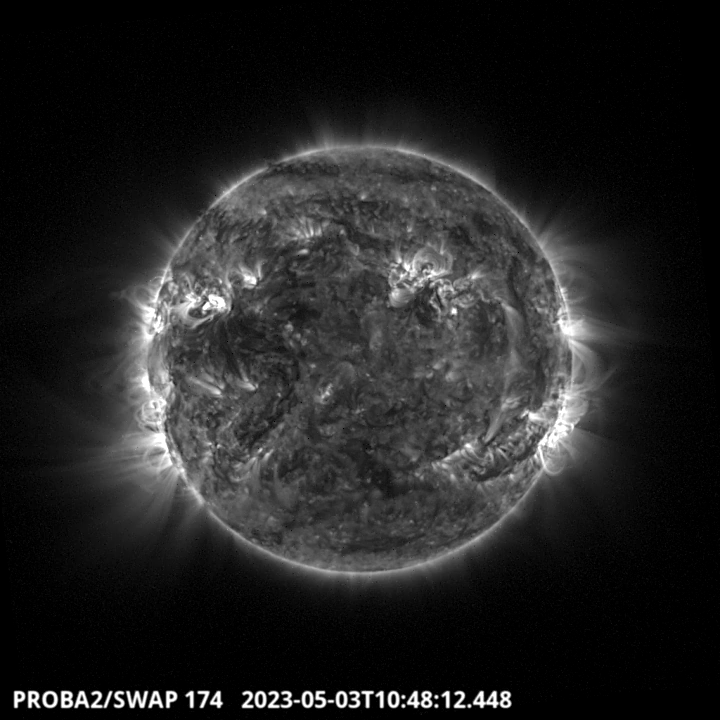
A large flow was produced around 10:48 UT on the north-east part of the solar disk. It has been classified as a M7.3 produced by the AR 3293. Find a movie of the events here (SWAP movie)
https://proba2.oma.be/swap/data/mpg/movies/20230503_swap_movie.mp4
Saturday May 06
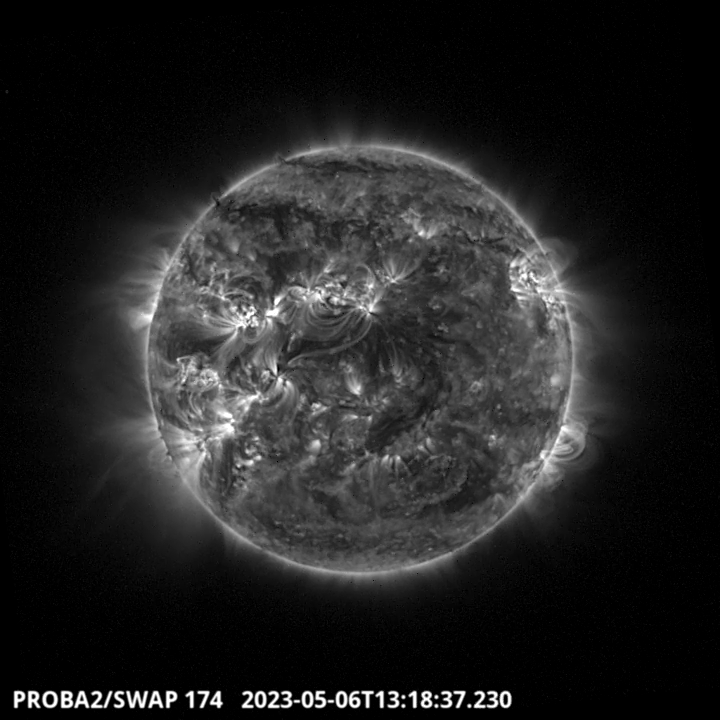
A filament erupted in the northwest part of the solar disk around 13:18 UT. Find a movie of the events here (SWAP movie) https://proba2.oma.be/swap/data/mpg/movies/20230506_swap_movie.mp4
International Sunspot Number by SILSO
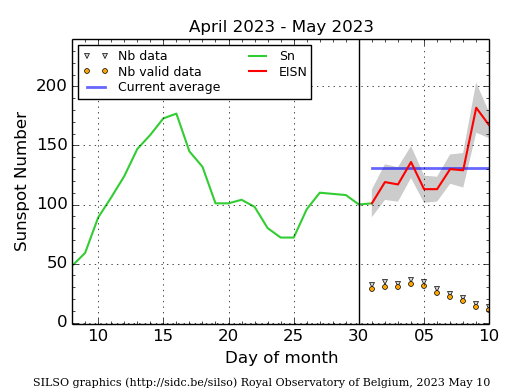
The daily Estimated International Sunspot Number (EISN, red curve with shaded error) derived by a simplified method from real-time data from the worldwide SILSO network. It extends the official Sunspot Number from the full processing of the preceding month (green line), a few days more than one solar rotation. The horizontal blue line shows the current monthly average. The yellow dots give the number of stations that provided valid data. Valid data are used to calculate the EISN. The triangle gives the number of stations providing data. When a triangle and a yellow dot coincide, it means that all the data is used to calculate the EISN of that day.
Geomagnetic Observations in Belgium
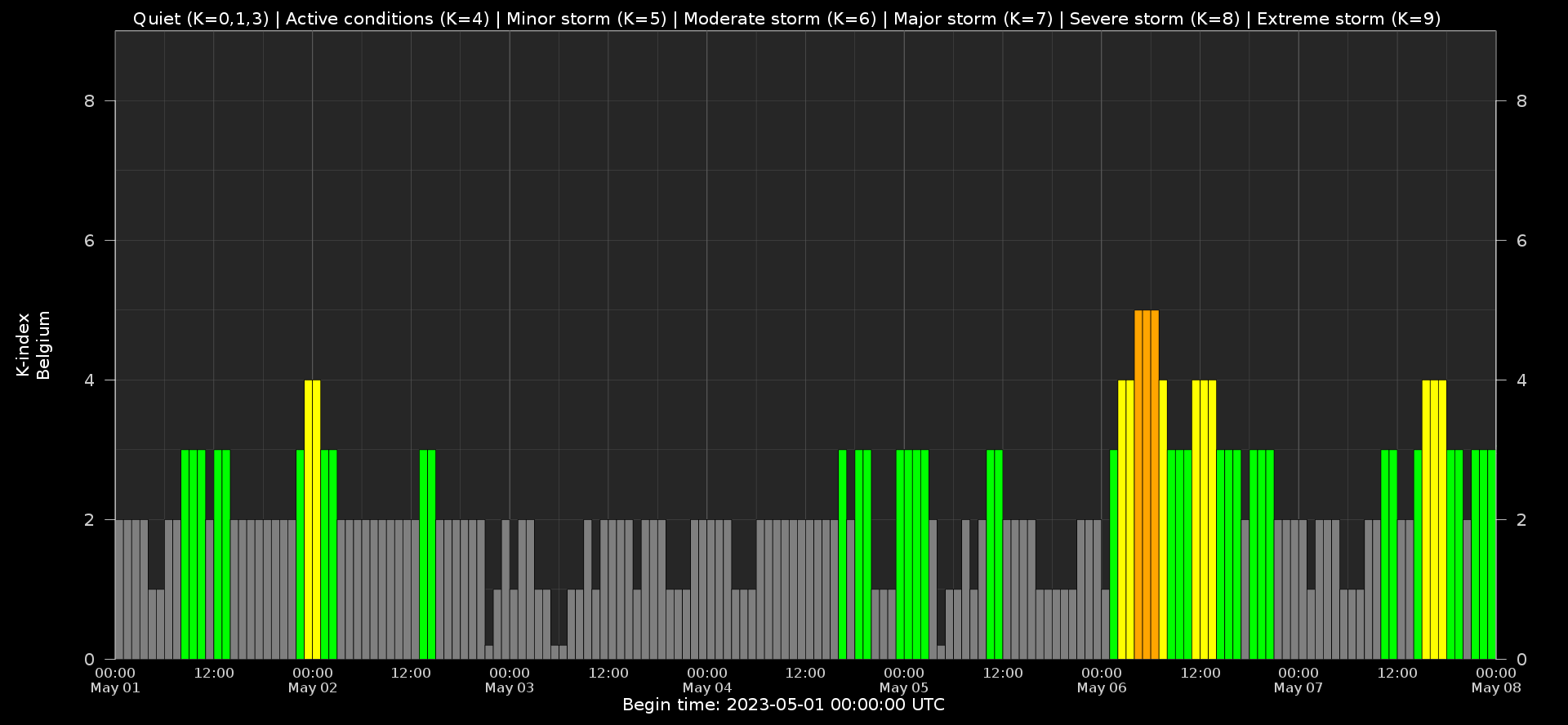
Local K-type magnetic activity index for Belgium based on data from Dourbes (DOU) and Manhay (MAB). Comparing the data from both measurement stations allows to reliably remove outliers from the magnetic data. At the same time the operational service availability is improved: whenever data from one observatory is not available, the single-station index obtained from the other can be used as a fallback system.
Both the two-station index and the single station indices are available here: http://ionosphere.meteo.be/geomagnetism/K_BEL/
Review of ionospheric activity

The figure shows the time evolution of the Vertical Total Electron Content (VTEC) (in red) during the last week at three locations:
a) in the northern part of Europe(N 61deg E 5deg)
b) above Brussels(N 50.5deg, E 4.5 deg)
c) in the southern part of Europe(N 36 deg, E 5deg)
This figure also shows (in grey) the normal ionospheric behaviour expected based on the median VTEC from the 15 previous days.
The VTEC is expressed in TECu (with TECu=10^16 electrons per square meter) and is directly related to the signal propagation delay due to the ionosphere (in figure: delay on GPS L1 frequency).
The Sun's radiation ionizes the Earth's upper atmosphere, the ionosphere, located from about 60km to 1000km above the Earth's surface.The ionization process in the ionosphere produces ions and free electrons. These electrons perturb the propagation of the GNSS (Global Navigation Satellite System) signals by inducing a so-called ionospheric delay.
See http://stce.be/newsletter/GNSS_final.pdf for some more explanations ; for detailed information, see http://gnss.be/ionosphere_tutorial.php
Agenda
Check out our activity calendar: activities and encounters with the Sun-Space-Earth system and Space Weather as the main theme. We provide occasions to get submerged in our world through educational, informative and instructive activities.
If you want your event in our calendar, contact us: stce_coordination at stce.be
* May 16, KUL/CmPA seminar: Magnetohydrodynamic modelling of Alfvén waves in the solar corona, 200B 02.16 and online, Leuven, Belgium
* May 22-24, STCE Space Weather Introductory Course, Brussels, Belgium - FULL
* May 25, STCE seminar: Comparative study of a constant-alpha force-free field and its approximations in an ideal toroid, Meridian room@spacepole and zoom, Brussels, Belgium
* May 25, RMI Seminar: Towards a new hydrometeors identification tool at the RMI, conference room of the RMI, Brussels, Belgium
* May 29 - June 1, PITHIA-NRF Training School, Rome, Italy
* June 12-14, STCE Space Weather Course for BKG, Brussels, Belgium
Check: https://www.stce.be/calendar
